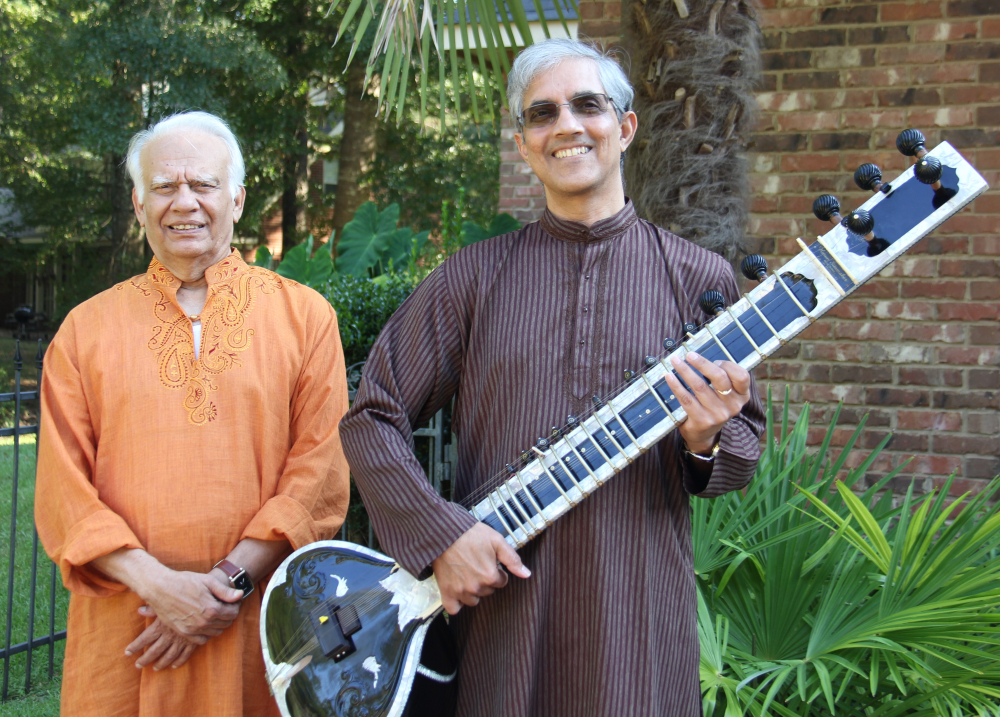On a late summer day in September, I met with Dr. Vish Shenoy and Hiranmay Goswami, two sitarists from Clinton, Mississippi. Hiranmay is an accomplished sitar player who has been playing for decades. He first learned to play while living in India, and brought his musical tradition with him when he moved to the United States in 1972. Over the years, he has taken on several students including Vish, who first started taking lessons with Hiranmay fifteen years ago. I had an enjoyable conversation with Vish and Hiranmay about learning, practicing, and performing on the sitar, Indian classical music, the instrument itself, and sitar playing in Mississippi. What follows is an abbreviated version of our hour-long conversation. This interview has been edited and condensed for length and clarity.
The Sitarists
In this section of the interview, Vish and Hiranmay talk about how they started learning the sitar, their practice schedules, and performing.
Hiranmay Goswami (HG): My name is Hiranmay Goswami, and I'm a civil engineer by my profession. I used to work for Entergy. Now, I'm retired. I have more time for my hobby, which is playing sitar. I learned when I was very young, age of 26. I got my teacher, Pradumna Das, who is a disciple of Ravi Shankar. Ravi Shankar is a world-renowned sitar player, and my teacher was a disciple of him. I requested him [Das] to teach me, and he was very glad. Before that I was learning from another sitarist. His name is Pijus Sen. So my old teacher [Sen], he said ‘I think you should take this opportunity because I have taught you whatever I had. Pradumna Das is a renowned sitarist, so you should grab this opportunity. So, that's my starting from him. I learned there for another maybe four or five years, and I got transferred to Calcutta. I was in Shillong which is a part of Assam North.
Then after that, I was carrying on with whatever I learned, you know. And then I came here in 1985, in Mississippi, actually. But in the United States, I came in 1972. So I had a very busy life at that time. I was doing my PhD courses in New York and working in a nuclear company. And my wife was very much busy with my kids. At that time. I was getting out of my sitar and following the regular PhD courses, plus my job as a civil engineer. Then after maybe five or six years, I think, my brother-in-law--he was in Montreal--and he came to New Jersey and he asked me ‘Hiranmay I heard you play sitar.’ And I said to him, ‘Yes, I know, but I am out of touch.’ And he said, ‘Please, I’d like to see you do the Sa Re Ga Ma Pa Dha Ni Sa. 1 ' The sitar was in the attic, so I brought it out. The thing is the melody of the sound hit me, and I picked it up again. Since then I am still practicing.
Maria Zeringue (MZ): Okay. So you started playing the sitar at 25 or 26 and then you took a few years break to do your job and your PhD coursework, and then when you were in your mid-30s, you picked it up again?
HG: Yes. And that sound, when I heard it, I said, ‘I will start again.’
MZ: Well, Vish let's hear from you. Why don't you introduce yourself and talk about how you got into sitar playing.
Vish Shenoy (VS): Well, I'm a gastroenterologist by profession. I moved to Mississippi approximately 15 years ago in search of better prospects. I listened to my teacher [Hiranmay] at a friend's house. We had a party, and he was playing. And I was mesmerized and got hooked. I requested him to teach me, and since the last 15 years, I've been taking lessons from him. So I usually take maybe two to three lessons a month mainly on a Sunday. And while I was working as a gastroenterologist, I had hardly any time to practice, you know. I put 60 to 80 hours per week working. So, there was hardly any time for sitar, but I struggled and kept going. Approximately a year ago, I had a brain tumor, and I had to quit my job. Because once you have a tumor, you know, you are at a risk for seizure, and you don't want to jeopardize somebody's life. So, I had to quit my job. Also, I have some difficulty in speaking, so that also hinders me from working. But it did help me with my sitar playing. Interestingly, the tumor is on the left side of the brain, and the speech center is on the left side of the brain in most people. So it did hinder my speech, but I think the music and musical playing is on the right side of the brain and that got enhanced. Actually, my sitar playing is at an all time best, and also I have more time to practice now. So that's my sitar story.
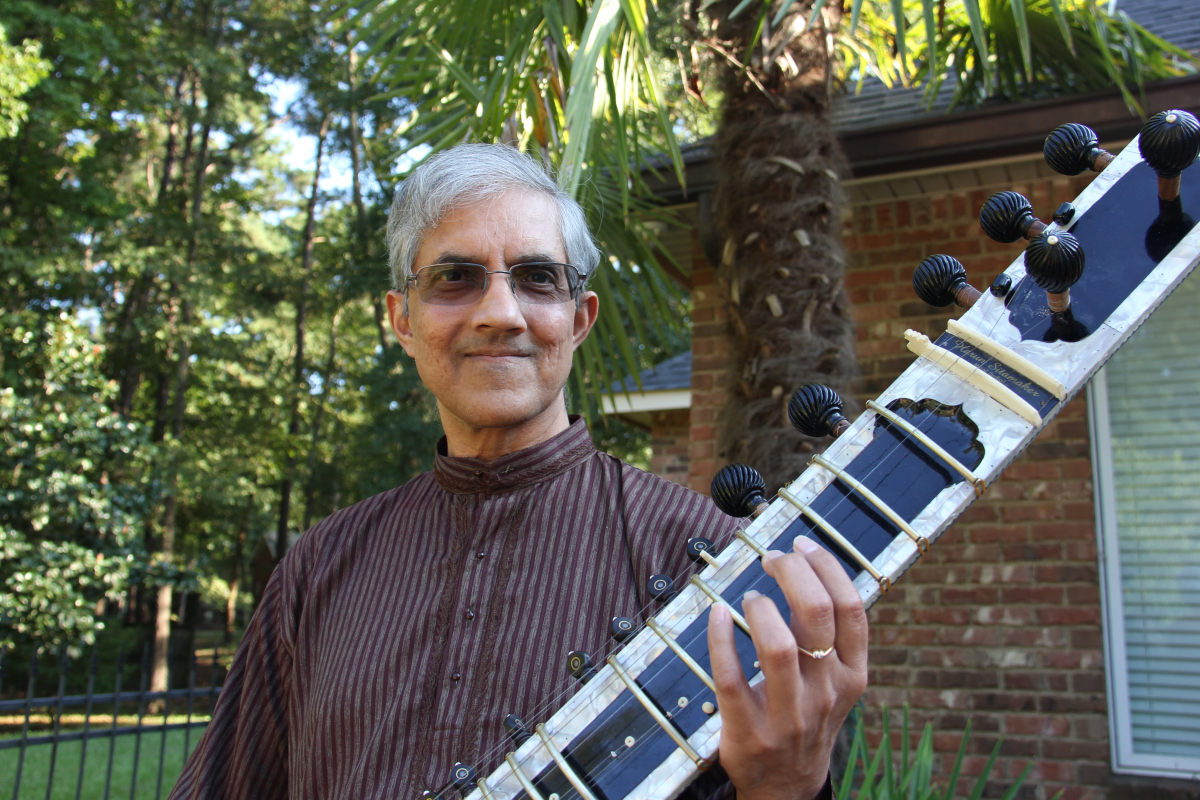
Vish Shenoy holding one of his sitars. Photo by Maria Zeringue, 2019.
MZ: I want to talk to both of you about practicing. What's your day-to-day your weekly schedule? Do you put in a certain amount of hours into sitar playing?
VS: To be a top-notch sitarist, you have to practice at least 4 hours a day. The professional sitarists, they dedicate their entire life. They start at a very young age, maybe 7 or 8 years old, with their teacher, and they practice anywhere from 4 to 10 hours a day for 20 to 30 years. These are very top notch sitarists, but sitarists like Uncle 2 may practice maybe 2 hours a day, you know. I'm practicing now at least 1 to 2 hours a day, and that's not enough to really play high quality sitar. You have to practice at least 2 to 3 hours a day.
MZ: And do you, Hiranmay, also have a similar kind of practice schedule?
HG: Yeah, in my case because I am also retired right now, I have plenty of time. I try to give one to two hours. Sometimes when I'm in the mood, maybe I spend more.
MZ: How long did it take you to become a competent performer where you felt really competent when you were on stage performing in front of other people?
VS: You know, learning to play is one thing, facing the audience and playing is another thing. The first time I tried, but I could not play at all. My hands went into spasm. I couldn't play, but I would say it took me two and a half to three years before I was comfortable playing a small piece in front of an audience. It wasn't a very musical or good piece, but I was able to play and people tolerated it. Now I can say I can make people happy, or make them listen to me without getting bored, you know.
The Music
In the days before our interview, Vish wrote me via email to give me an introduction to sitar music. What follows is Vish’s written summary of Indian classical music.
The fundamental unit of Indian classical music is a raga. There are hundreds of ragas, some dating back to 2000 years. Every raga has an ascending and descending movement, and within this framework, the musician improvises and expands the melodic outline. In fact, Indian classical music is 90 percent on the spot improvisation and 10 percent fixed composition.
The word raga means “coloring of the mind.” Ragas have a particular scale and melodic movements, and their characteristic sound evokes moods or emotions, such as pleasure and delight in the minds of the listeners.The nine principle sentiments that are evoked by the raga are romance, humor, sadness, excitement, bravery, fear, disgust, amazement and peace. Some of the sentiments evoked by the ragas are better expressed by singing, rather than playing it on an instrument.
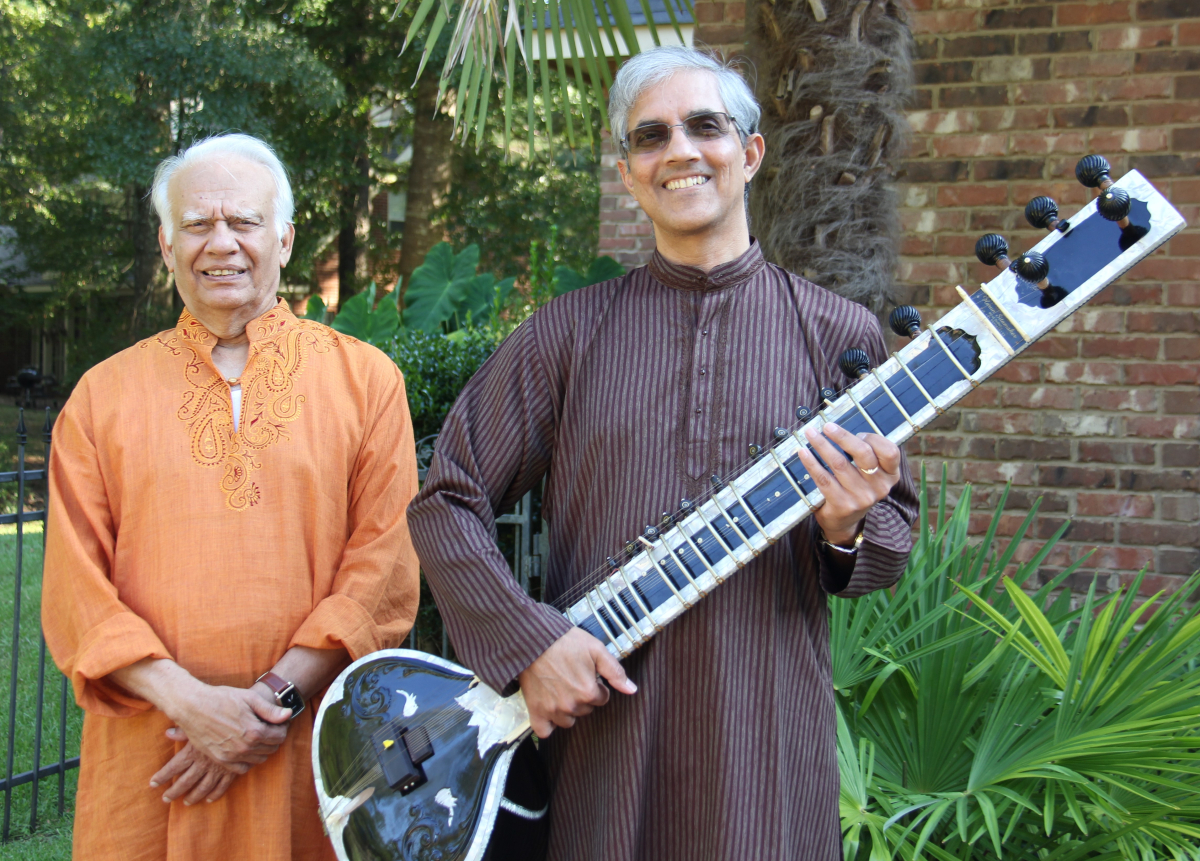
Hiranmay Goswami (left) and Vish Shenoy (right). Photo by Maria Zeringue, 2019.
The raga usually begins with an ‘alaap’- a slow progression, illustration, and union of notes of a given raga. In the alaap section, the musician incrementally creates the mood of the raga, capturing the imagination of the listener, and at times hypnotically transforming their emotions. When played by a master musician such as a pundit or Ustad, a raga can alleviate fatigue, energize, and bring peace and calm in the heart of the listener.
Indian classical music is usually accompanied with a drone instrument called tanpura. During the rendition of a raga, the instrumentalist and percussionist freely improvise. The percussionist holds a steady tempo, allowing the instrumentalist to improvise, and later the instrumentalist repeats a phrase several times, giving the percussionist an opportunity to improvise. The rhythmic cycles by the accompanying percussionist is called a tala. The first beat of the tala and the first note of the melodic movement of the raga should always coincide, even during an improvisation and this important focal converging point is called the sum. There are innumerable rhythmic cycles such as Teen tala: a cycle of 16 beats; Kehrwa: a cycle of 8 beats; Jhaap tala: a cycle of 7 beats, and so on. These cycles of improvisation span through many tempos. The melody begins with a slow tempo and over time accelerates, culminating in an extremely fast tempo called Jhala, finally ending in a climax.
Many genres of music from the Indian sub-continent such as folk, devotional, theatrical, and Bollywood all find their roots in ragas. Even western hits such as “Black Magic Woman” by Santana and “Scarborough Fair” by Simon and Garfunkel are based on ragas.
In our interview, I asked Vish and Hiranmay some questions to expound upon this summary of Indian classical music. What follows is a part of our conversation on the subject.
MZ: I want to talk a little bit about improvisation. In the summary you gave me, you said that sitar music is 90% on the spot improvisation and 10% composition.
VS: Each week Uncle will teach me two improvisations, so I practice those every week. To complete a raga, it takes about anywhere from three to six months, you know, because he will give me all these different improvisations or different rifts, like in western music. What they called rift in Western music, in our music, we call it tans. The raga moves into several phases… and each raga might last anywhere from 25 minutes to an hour depending upon how much improvisation you can do and most top musicians, you know, whatever they learn they are not just playing that. They are improvising a lot on the spot. The more you play, the more expert you are, the more improvisation. So in my hands, it's not going to be 90% improvisation. So Uncle if you want to add anything, go ahead.
HG: Yeah, mood is a very important thing actually. If I play you right now something of the morning raga. Your feeling will be as if you are getting up in the morning, something like that. That's the mood it creates. So raga, actually, it creates a mood. And mood is also created by the audience. If I see it, I can feel it. I see your mood and how you are taking it in, you know. If you are in a good mood to accept these things, my mood also gets up, you know. It is a two way street.
And I wanted to emphasize one thing. This whole thing, our classical thing is very old. It is about 3,000 years or more than that. Raga is a mind coloring. So people used to color their mind with the Divine who created us. They say raga is another form of yoga. Yoga means union, so all these things started with playing for the Divine Soul, God.
MZ: So it has a spirituality?
HG: It has a very spiritual aspect, and people get motivated by it and they are happy. The guy who does this, he does it for his happiness because it is a union with the super force, you know.
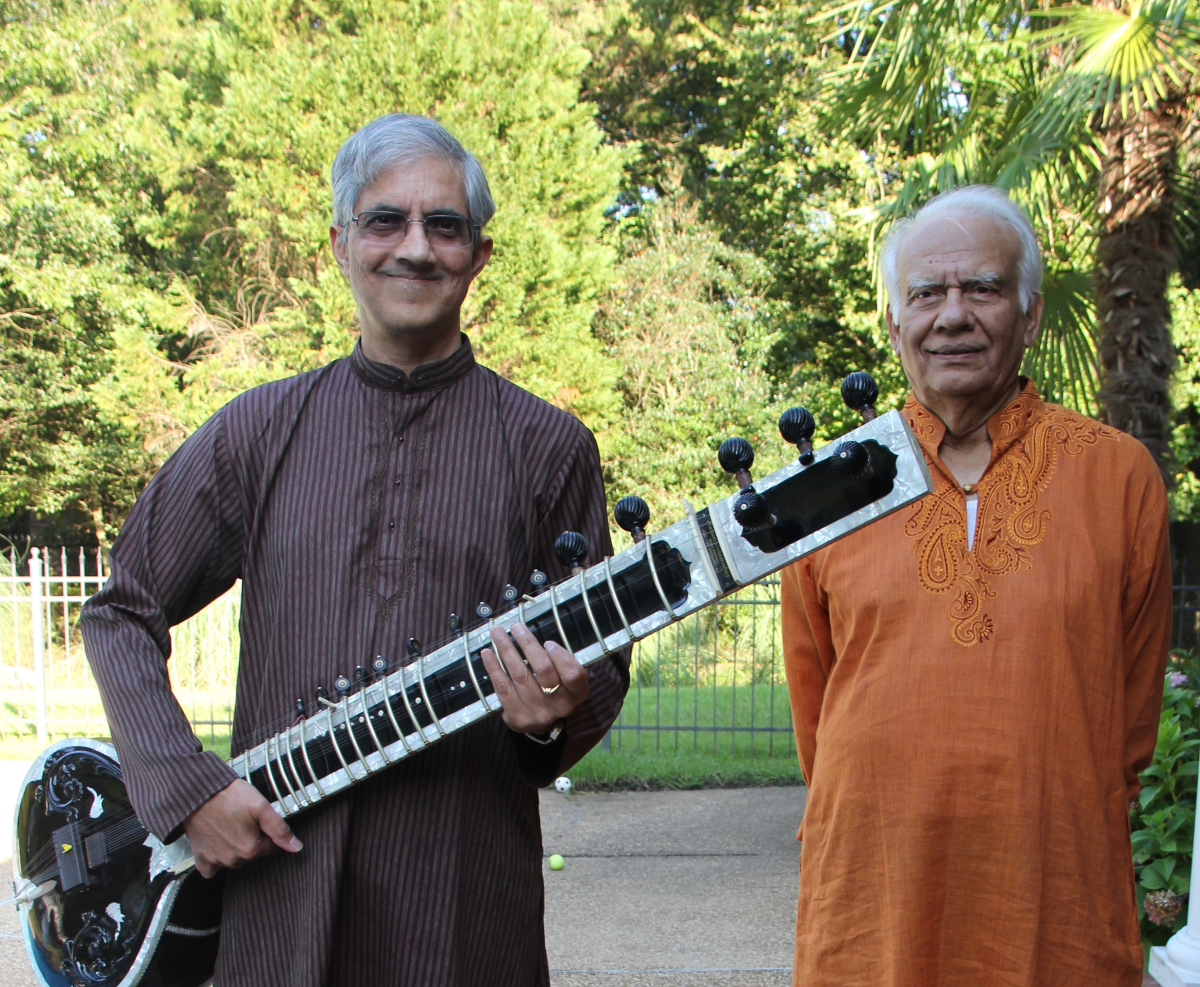
Vish Shenoy (left) and Hiranmay Goswami (right). Photo by Maria Zeringue, 2019.
The Instrument
During our interview, Vish had two beautiful sitars out and spoke briefly about the networks in India and the US that are involved in the production of the instrument. He also discussed learning how to do basic maintenance on his sitars since there are no sitar makers in Mississippi or in nearby states.
MZ: Do you have to go to a bigger city to get your sitar or do you order them online?
VS: So, it's available online. These online sitars were made in India, and they were brought here. But the online sitar, it's hit and miss, you know. When they arrive, they get damaged and sometimes they're poorly made. They are made in mass quantities to be shipped to the United States and to give it to people who don't know what a sitar is. So you might get a bad quality sitar. The best quality sitars are made by some families in India. There may be 5 to 10 families scattered in few cities of India: Calcutta, Delhi, Miraj and a few other places. And those people know how to play sitar, so they make the sitar. They play it, and they make sure it works. It's best to buy from those people. This particular sitar [gesturing to his sitar] was made by a family who have been making sitars for the last, I guess, five decades. That guy brought it to my town, and he made sure it was working well, and then he left. So he had traveled maybe 5 hours by train to bring the sitar to me.
MZ: Oh, wow. You had talked about getting repairs. You said there were a few good shops in bigger cities in America, but mostly you have to do them yourself?
VS: Yeah right. So there's there's a guy in Seattle. He is a caucasian guy who went to India, learned sitar, and learned how to fix it. He owns a sitar store in Seattle. And then there are a few in California, few in Austin, but they are very expensive to get it fixed. So, you have to try to fix it yourself.
Sitar Playing in Mississippi
As Vish and Hiranmay stated, to the best of their knowledge the sitar community in Mississippi is very small. There are only a handful of players in the state, and most of them are concentrated in the Jackson metro area. In our conversation, both Vish and Hiranmay explained that the small number of players is partly due to the fact that the sitar is a difficult instrument to master, and it is expensive to buy and maintain. Sitars can cost from several hundred dollars to thousands of dollars. Hiranmay added that he has had several students over the years, but due to the time it takes to master the instrument, some of his students have had to stop their lessons because the time commitment can be overwhelming, especially to those with jobs and young families. Most of those who do play, have the passion, resources, and dedication to master the sitar. In this last section of the interview, Vish and Hiranmay discuss the sitar network in Mississippi, performing, and what they like about playing.
MZ: Let’s talk about sitar playing in Mississippi. Is there a robust community of sitar players here? Do you have a lot of people that you can play with?
VS: Even if you go to any place in the United States there are very few sitar players. Even in India, there are very few sitar players because it's a very difficult instrument to master. So in Mississippi, as far as I know, there are only four people who know how to play sitar. One is my teacher, and second, is me. Then third, is his [Hiranmay’s] other student, but she has not performed anywhere because she is also a mom and very busy. She has accompanied Uncle in playing a few places. And then there's a fourth guy who just moved in, but I don't think he has practiced. So he is not playing. He is mainly singing. He doesn't play a whole lot, but he has learned sitar.
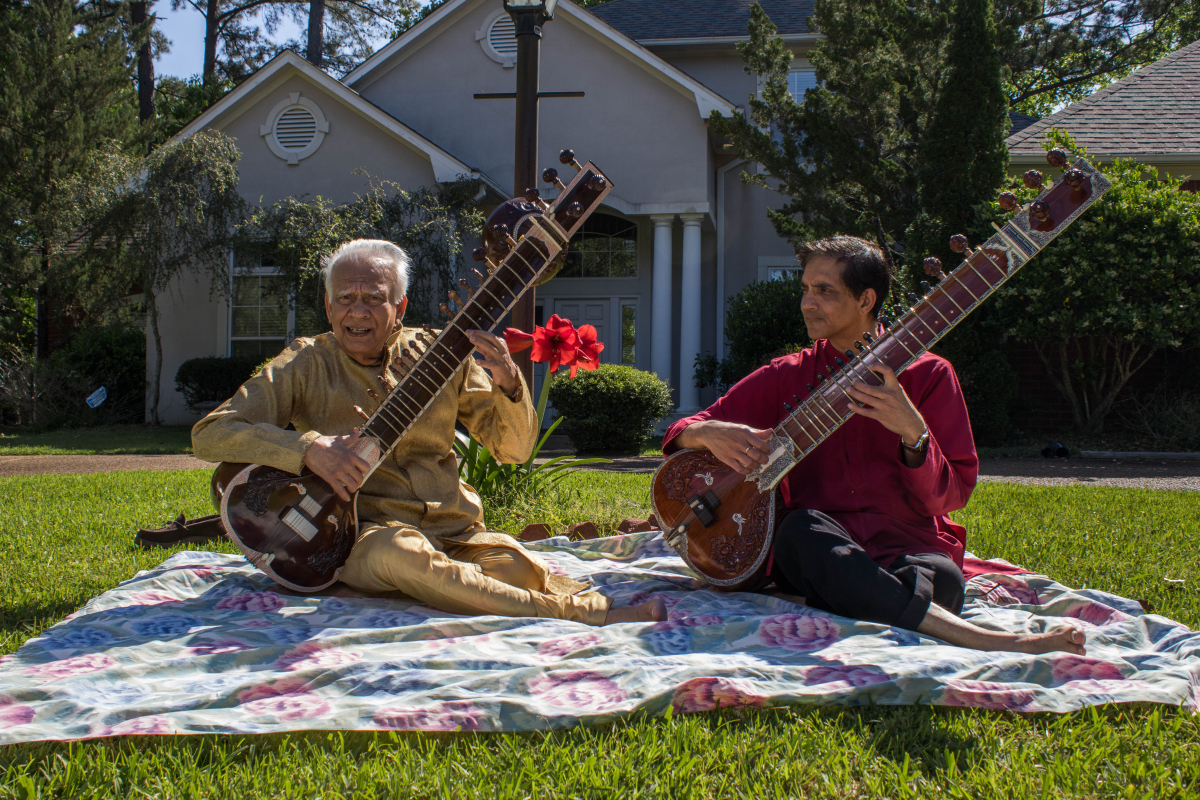
Hiranmay Goswami (left) and his student Vish Shenoy (right). Photo courtesy of Vish Shenoy.
Uncle used to perform a lot, but I think he has slowed down now. I perform at any place if I get an opportunity. So I played in India, in New Jersey, in New Orleans, Birmingham, and Mississippi. If there's a chance, I would love to play. But there are not a whole lot of sitar players because the reason is the sitar is a difficult instrument. It's a solo instrument, and it's a classical instrument, and many people don't like classical music, you know. But wherever I have played, they liked it, and they felt it was very relaxing.
MZ: You said there's usually a percussionist who accompanies a sitar player. Are there a few of those percussionists in this area or in Mississippi?
VS: I would say there are only three percussionists who can really accompany Uncle or myself when we play Indian classical music. One was a young kid, he played a drum. He moved on to Boston. He is a top-notch percussionist in that particular instrument, and he is the only guy who knows how to play that in two or three states. Then there are two other percussionists who play a drum called a tabla, but they're busy and not easily available. So we usually use a drum machine when we practice.
MZ: So are the sitar players that you know from the Clinton or Jackson area?
VS: So the only two sitarist who are playing regularly are right here. [gesturing to himself and Hiranmay]. And then the other percussionists: there's one is in Clinton, and one is in Jackson.
HG: If you go to the big city, you really see quite a few like in New York or California.
VS: You might get 10 [sitarists] instead of 2. But Mississippi is fortunate to have Uncle here. You know, he is a Himalaya of sitar music, and I'm fortunate that I learned for 15 years from him and I learned a lot. So you're looking at the sitar team of Mississippi [gesturing at himself and Hiranmay]. That's it. [laughs].
MZ: What do you like about playing or performing? What is your favorite thing about the sitar and playing music on this instrument?
HG: It attracts. Sound attracts.That's the only thing I can say. Sound attracts and then you get absorbed. That's how I was saying that it is a divine thing. You know, when somebody else will play, you'll feel divine.
MZ: Well thank you both so much.
VS: Thank you very much for giving us the opportunity.
HG: Thank you, and if you have any other questions let me know.

